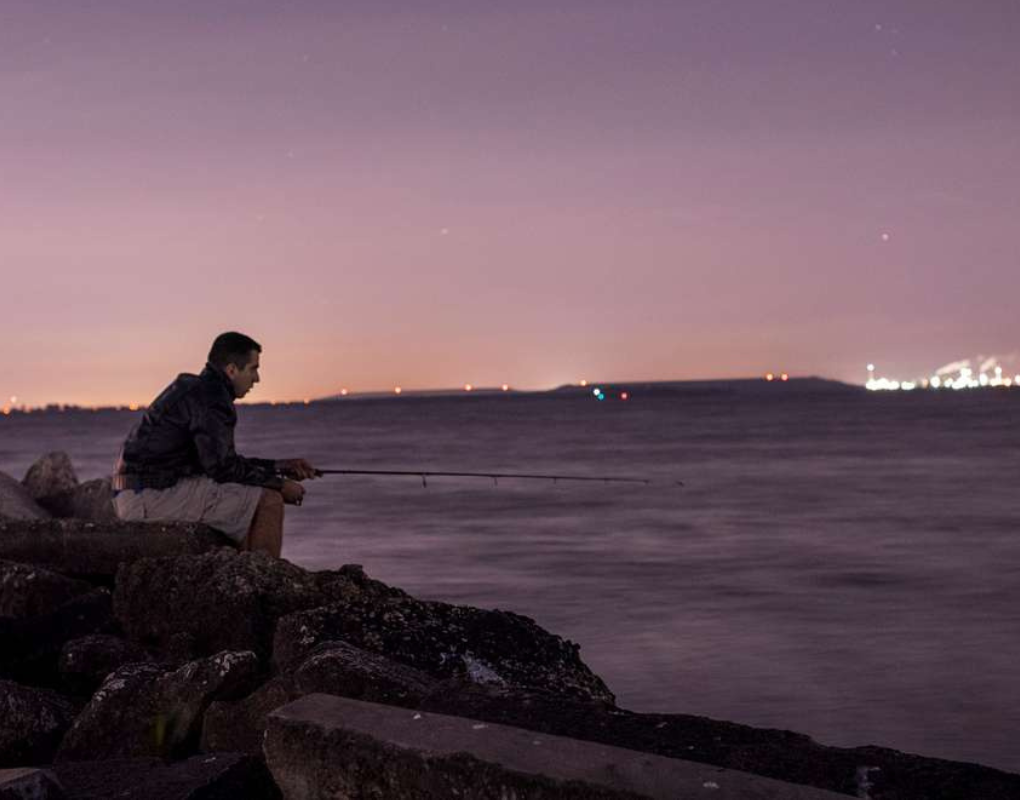For successful night fishing, use illuminated or reflective lures and stay quiet to avoid scaring fish. Ensure your safety by wearing a life jacket and using a headlamp for visibility.
Embracing the tranquil ambiance that night provides can make fishing a unique experience. The cover of darkness often brings out the more elusive species, providing enthusiastic anglers with a thrilling challenge. To optimize your chances for a good catch, it’s essential to plan your trip considering the moon phase since it affects fish behavior.
Opt for slower, more deliberate movements with your bait to mimic nighttime prey. Gear preparation is critical; equip your tackle box with items specifically designed for low-light conditions. Safety should always be a priority; never compromise on protective equipment or informing someone about your fishing spot. By following these guidelines, night fishing can transform from a daunting prospect into an exciting and fruitful endeavor.
The Lure Of Night Fishing
Night fishing opens up a new world for anglers. Under the cover of darkness, the water grows quiet and fish behavior changes. It offers a peaceful alternative to day trips. The stars reflect on the calm water, creating a unique experience.
Yet, night fishing brings its challenges. You must navigate in low visibility and adapt to cooler temperatures. It requires special gear, such as lights and reflective markers. Despite these, the rewards can be great. Many species are more active and less cautious at night. This means better chances at a big catch.
Prepare with the right equipment and knowledge. This will turn night fishing into a safe and successful adventure. Always tell someone your plans. Safety should be your top priority.
Gear Essentials For Night Fishing
Selecting the proper rod and reel is crucial for successful night fishing. One should opt for a medium-heavy rod for strength and flexibility. The reel should be smooth and reliable to efficiently handle nocturnal fighters. It’s best to aim for gear that boasts enhanced sensitivity to detect subtle bites in the dark.
Finding the right bait and lures is key. Glow-in-the-dark lures are highly effective as they attract fish with their visibility. Live bait like minnows or worms also work wonders for luring fish. Ensure your tackle is equipped with noise-making additions to mimic the sounds of prey and draw fish in. Table below showcases optimal selections:
| Rod Type | Reel Type | Bait Type | Lure Type |
| Medium-heavy | Smooth, with good drag | Minnows, Worms | Glow-in-the-dark, Noise-makers |
Lighting Up The Dark
Night fishing demands proper lighting for success and safety. Selecting between headlamps and dock lights depends on personal preference and the type of fishing. Headlamps offer hands-free convenience, making it easier to manage gear. They also focus light wherever you look, crucial for tying knots and baiting hooks.
Dock lights, on the other hand, illuminate a broader area. They can also attract fish, enhancing your chances of a good catch. Yet, they are less mobile than headlamps. Both options can be effective, so it’s wise to consider the situation.
- Headlamps: Hands-free, mobile, directs light where needed.
- Dock Lights: Lights up larger area, can attract fish, less mobile.
For navigation, always use navigational lights. These are legal requirements to ensure other boats can see you. Proper lighting can prevent accidents on the water. Safety should be a top priority. Before heading out, always verify local regulations.
Electronic Enhancements
Fish finders shine for night fishing. They show fish locations in the dark water. Split your screen; one side for fish finding, the other for mapping. Bright, clear displays help you see well in low light.
Turn on fish alarms for instant alerts. Adjust the backlight to avoid glare. GPS and chart plotters keep you safe. They guide you away from dangers. Always mark your starting point. It helps find your way back.
| Fish Finder Tips | Safety with GPS/Plotters |
| Use split-screen mode | Mark your starting location |
| Set fish alarms | Follow plotted courses |
| Adjust backlight to suit | Keep an eye on depth charts |
Fish finders and GPS boost your catch and safety. Trust in these tech tools. They lead to success and bring you home. Keep your fishing trip fun and worry-free. Always double-check gear before leaving.
Tackling The Darkness: Techniques That Work
Night fishing presents unique challenges and demands specific strategies. Topwater tactics prove effective when fish surface to feed. Cast your lure and wait for the telltale ripples. Use a light-stick or luminescent bobber to track your lure’s location. Popping or walking-the-dog techniques with your rod can provoke strikes from curious fish. Short, consistent twitches of your rod tip make your lure dance enticingly on the surface.
Bottom Bouncing strategy involves a weighted setup, allowing your bait to sink. Essential gear includes a sinker, a good-quality swivel, and a durable fishing line. Bait should scuffle along the substrate, mimicking a natural meal. Use slow, deliberate retrieval to allow fish to locate your bait. Employing scent attractants or noise-making sinkers can improve your success rate in the dark waters.
Targeting Nocturnal Species
Night fishing brings unique challenges and rewards. Fish behavior changes after dark, adjusting to dimmer light conditions and cooler water temperatures. Successful night anglers know that nocturnal predators are often more active and hunt closer to the shoreline or surface.
To capitalize on these conditions, employ techniques tailored to specific species. For instance, use glow-in-the-dark lures for bass, as they rely on vision for hunting. Alternatively, consider scented baits for catfish because they use their strong sense of smell. These methods increase your chances of a catch, as fish are attracted to these specific sensory cues.
| Fish | Technique | Lure/Bait |
| Bass | Vision-focused | Glow lures |
| Catfish | Scent-focused | Scented baits |
Quiet As The Night: Stealth In Fishing
Mastering stealth is key to a fruitful night fishing experience. Soft footsteps and gentle movements near the water edge are crucial. Use a paddle or electric motor for a quiet approach. Be mindful of shadows and avoid sudden light.
Avoid dropping gear on the boat’s floor. Instead, place items down gently and with care. Fishing lines should be cast smoothly and silently. The calmer you are, the better your chances of not scaring the fish away.
Moon Phase Matters
Understanding the lunar cycles is crucial for night fishing success. Moonlight affects fish behavior, so choosing the right time is key. A full moon offers more light, making fish more active and easier to attract. Conversely, a new moon results in darker nights, which can lead to challenging but rewarding fishing conditions as some fish rely on the cover of darkness to feed. Anglers should consult a moon phase calendar to plan their trip. Aligning your fishing trip with the preferred activities of your target fish during various moon phases can significantly increase your chances of a good catch.
Weather Wisdom For Night Anglers
Night fishing demands knowledge of the weather. Successful anglers often check the forecast before heading out. Clear skies and stable weather patterns usually make for ideal conditions. Understanding moon phases can also give you an edge. Full moon nights often provide enough light for effective fishing.
Dealing with bad weather needs careful planning. High winds can be dangerous and make fishing tough. Light rain might be good, as it can bring fish to the surface. Yet, always be ready to pack up if the weather turns ugly. Safety must be your top priority. Always wear a life vest and tell someone your plan. Bring gear that can handle wet and cold conditions to stay comfortable and secure.
Staying Comfortable And Alert
Selecting the right clothing is vital for a comfortable night fishing experience. Wear layers to adjust to changing temperatures. Including a waterproof and windproof jacket is smart. Don’t forget insulated gloves and a beanie to keep your hands and head warm.
Combatting sleepiness during late hours requires strategy. Stand up and move around frequently. Try light exercises to improve blood circulation. Drink water or hot beverages to stay alert. Snack on healthy foods like nuts or fruits.
Secret Spots And Locations
Discovering hidden fishing spots at night can often lead to the best catches. Scout for these hidden havens during the daytime. Look for areas with less noise and fewer people. Features like underwater structures are perfect for attracting fish at night.
Talk to local anglers and bait shop owners. They know the waters well. They often share valuable insights about where the fish are biting. Remember, the best fishing holes are sometimes the least obvious. Use their advice to prepare your night fishing adventure.
Catch And Release: Nighttime Best Practices
Night fishing requires careful handling of fish for safe catch and release. Be sure you have a good grip to avoid dropping the fish. Use wet hands or gloves to reduce skin damage to the fish.
Always keep the fish over water when unhooking. That way, if it slips, it falls back into the water. Barbless hooks can make the release faster.
Remember the goal is to minimize stress on the fish. Quick handling is essential. Use a light source like a headlamp to see without using your hands. This makes safe handling in the dark easier.
Think about the fish population and future generations. Always follow local conservation rules. Release fish gently, supporting its belly until it swims away.
Memorable Night Fishing Stories
Night fishing adventures often yield thrilling tales. Each cast can unravel mysteries within dark waters. Anglers share stories of unexpected catches and the serene beauty of the lake at midnight. From the silence of the night to a sudden tug on the line, these moments create lasting memories.
Under the twinkling stars, every fisher learns valuable lessons. Precision and patience are key to success. Mastering the use of lures and baits takes on a new importance. Navigation and safety practices ensure a safe return at dawn.
Conclusion: The Quiet Thrill Of Night Fishing
Night fishing presents a unique adventure, unlike its daytime counterpart. The stillness of the evening air coupled with the soft glimmer of stars sets the stage for a serene experience. Anglers should always respect the quiet beauty of nature, making sure to leave no trace behind.
Practicing responsible fishing habits is paramount. Use barbless hooks, handle fish with care, and release them quickly back into the water. Remember, preserving our fisheries ensures that night fishing remains a joy for years to come.
Frequently Asked Questions On Night Fishing Tips
What Is The Best Bait For Night Fishing?
The best bait for night fishing typically includes live baits such as minnows, worms, and shrimp, due to their strong scents and movements attracting fish in low-light conditions.
What Is The Best Time To Fish At Night?
The best time to fish at night is usually an hour after sunset or the hours just before sunrise, aligning with peak fish activity.
What Color Lure Is Best For Night Fishing?
For night fishing, opt for dark-colored lures such as black or blue as they create a strong silhouette against the nighttime light conditions, making them more visible to fish.
What Fish Are Better To Catch At Night?
Night fishing often yields success with catfish, walleye, and bass. These species are generally more active and feed during the night.
Conclusion
Embracing the stillness of the night while fishing can yield great success. Remember, patience and preparation are key. Armed with the right gear, knowledge of the lunar phases, and a willingness to adapt, you’ll enhance your night fishing experiences. Cast a line under the stars and relish the peaceful adventure.
Success awaits in the moonlit waters.

